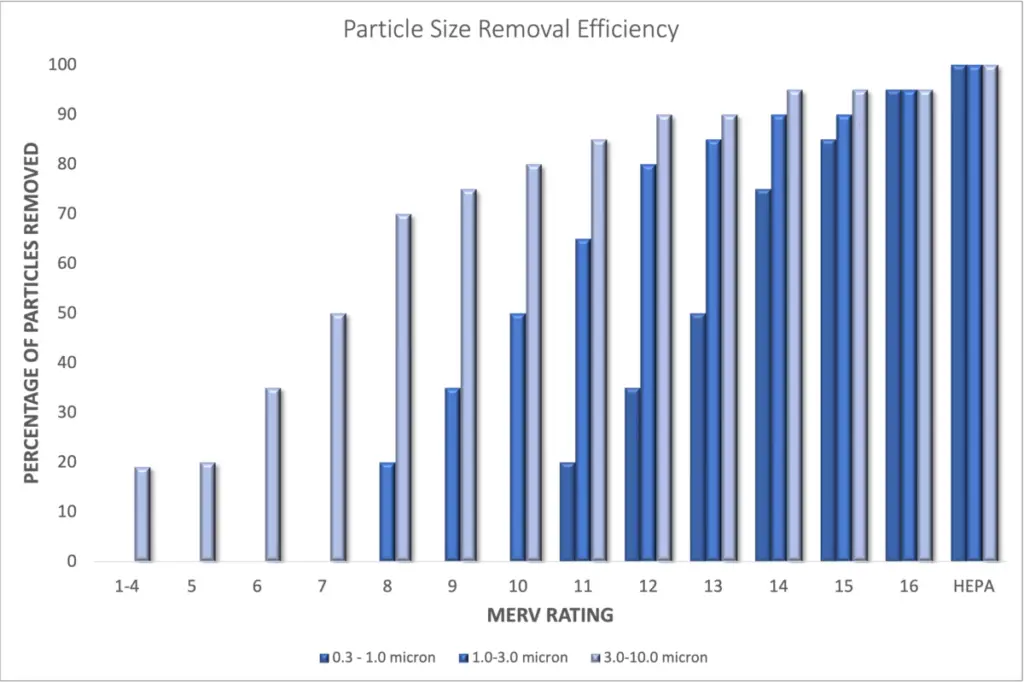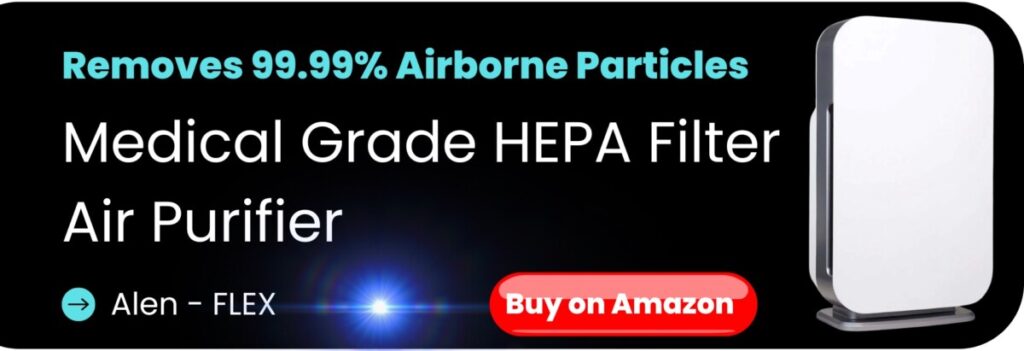Furnace filters remove contaminants from the air before heating it, making it safe to breathe. It is natural for the filter to accumulate dust and debris, and become dirty after some time. If the air filter is always clean, it implies a lack of filtration.
Furnace filters that are never dirty are caused by inefficient filtration because of loose-fitting or oversized filters, a blockage at the entrance of the filter, the incorrect placement of furnace. Low filtration efficiency can also be due a low MERV rated filter (i.e., <7). A HEPA air purifier operating in the same room can also lead to furnace filters that remain clean.
Ineffective filtration has severe health implications and can cause blockage and malfunction in other parts of the furnace. Please read this article to learn about various potential reasons that may be causing the problem, their easy diagnosis, and quick fix.
How Does a Furnace Work?
Before we proceed, let’s take a quick look at how furnaces work to make it easier to troubleshoot your filter problem:
- Once the unit is switched on, an inflow of cold air starts.
- The incoming air first passes through the filter installed on the side or floor of the furnace.
- Pet hair, dust, debris, and other large airborne particles are removed during filtration.
- The air then exchanges heat from combustion gases in the heating chamber.
- Air is then emitted into the room, and the exhaust gases are released through the metal flue and vent.
Air filters have a specific capacity beyond which they cannot trap contaminants. Since pollutants are always found in the air, your furnace filter should typically become saturated after a few months. However, the time varies depending on the MERV rating of the filter.
Why is it a Problem if the Air Filter is Always Clean?
An air filter that doesn’t get dirty because of inefficient air filtration can lead to several other problems:
Health Implications
Air filters in appliances (including furnaces) are crucial to protect against allergies. Ineffective filtration can cause severe allergic reactions due to pollen and other allergens remaining in the air. It can also aggravate pre-existing asthma, emphysema, and other respiratory disorders.
Wheezing, chest pain, headache, and nausea are symptoms that generally manifest in people living in low air quality index (AQI) areas.
People are also vulnerable to infections due to bacterial and viral exposure.
Damage To The Furnace
If the furnace filter doesn’t remove airborne contaminants, they circulate along with the air throughout the system.
- Molds and fungi can build up anywhere in the system, harming the metal chamber and plastic pipes.
- Dust and debris can accumulate in furnace components, obstructing the airflow.
- Clogs can form in the drain pipe, preventing the water (condensate produced in the metal chamber) from draining out of the unit. This collected water can make the filter and other parts wet, preventing them from working correctly.
Plentiful Air has more detailed information on wet furnace filters, and how to fix them, available here.
- The inefficient airflow can send the system under stress, causing it to overheat. If not addressed immediately, this can lead to the formation of carbon monoxide and other toxic gasses.
- Since the furnace is on, it will continue to consume electrical energy but won’t heat the air properly. This adds to the electricity bill.
5 Reasons Why a Furnace Filter Is Never Dirty
Here are the reasons why you might find your furnace filter is always clean:
1. Loose Filter
One of the first things you should check for if your furnace filter is not working is if it is secured well in place. Turn your furnace off and manually try to slide your furnace filter. If the filter moves freely, it indicates it is loose.
Fix
Confirm if your furnace filter is the right size.
Then, take the air filter out, and slide it into the slot again. Most air filters have arrows indicating which way you should install them. Ensure that this arrow is pointing towards the furnace.
After installing the filter, move it again and check if it’s tight. Ideally, the air filter should snugly fit in your unit, i.e., it shouldn’t be moving too freely and shouldn’t be stuck either. Buy a replacement filter if the old one doesn’t fit.
2. Oversized Filter
The size of the furnace filter is a critical determinant of the quality of air filtration. If the size of your air filter is not compatible with the furnace, it won’t fit in correctly, and this will hamper filtration.
You should avoid an oversized furnace because it will heat the room up too quickly (short-cycling) and to almost uncomfortable levels. Therefore, it is essential to calculate the appropriate furnace size for your space and its compatible filter size. The area covered by a particular unit is always mentioned in its product description.
Try moving the filter manually. If it is stuck and hard to move, it is likely oversized.
Fix
Replacing the filter will resolve the problem. Filter size is usually calculated in terms of MERV rating (thickness).
Typically, a MERV rating of 8 to 10 is considered ideal. However, for people with respiratory disorders or general distress in breathing, a MERV rating of 11 is appropriate.

You can also refer to your furnace’s user manual to get an idea of the appropriate filter size. It is also sometimes printed on the furnace frame.
3. Low-Efficiency Filter
Another reason your filter might not work correctly is its low efficiency. MERV rating, i.e., the thickness of the filter, determines the efficiency. A higher MERV rating implies smaller pores, which understandably filters more contaminants.
Often, one-inch filters are used in furnaces. Although they are cheap and easy to install and maintain, they don’t do much in terms of filtration.
If your air filter is the correct size and fits perfectly in the furnace, you should check its MERV rating.
Fix
Although a higher MERV rating implies efficient removal of air pollutants, it has a downside. Excessively thick air filters can take up a lot of space and block the airflow. Therefore, always go for filters in the ideal range of MERV ratings, i.e., 7 and 12.
4. Obstruction in Air Flow
We know that air flows inside the system for filtration. If the air inflow is compromised, it won’t reach the filter, so your filter will always be clean.
This issue mainly arises due to dust and debris buildup. There might also be an obstruction at the unit’s entrance preventing the air from entering inside.
Another (less common) reason for inadequate airflow can be the incorrect placement of the furnace. Placing the unit in a confined space can block the entrance and prevent or reduce incoming airflow.
Any clog at the entrance is typically visible when seen under torch light. You can confirm the problem by checking the outflow of air. If hot air is not blowing out of the furnace into the room, it is a sign of obstructed airflow.
Fix
Cleaning the obstruction will resolve the clog. First, check how bad the clog is. If the buildup is not hardened, you can try removing it by hand. If that doesn’t work, you can also use the vacuum to clean the entrance.
If the furnace is placed in a small room, or its entrance is close to walls, change its position and see if it works to clear the air flow path.
5. HEPA Air Purifiers
HEPA air purifiers employ highly efficient HEPA filters that remove over 99% of dust, debris, and microscopic particles and pathogens. If you are running a HEPA air purifier in the same room as the furnace, it is likely that your air purifier is removing most of the pollutants, and the air entering the furnace is relatively clean.
As long as the furnace is working fine, this is normal and shouldn’t be a problem.
Which Side of the Furnace Filter Should Be Dirty?
The furnace filter should be dirty from the side that encounters the air first, i.e., the side facing away from the furnace.
The furnace filter should get dirty from the side the air comes in. It is sometimes normal for air filters to get dirty from both sides due to excessive pollution, but mainly the front side (facing away from the furnace) should be saturated.
If your filter is always dirty from the inner side, here’s what you should do:
- Turn the appliance off and detach the filter.
- Clean the filter using a low-power vacuum or wash it using lukewarm water.
- Let it dry and install afterward.
- If the problem persists due to poor AQI, install a new filter with a slightly higher MERV rating.
- Also, consider installing an air purifier in the room.
How Dirty Should a Furnace Filter Be?
After a few days of use, dust on the furnace filter should be visible. Once the filter has been in use for three or more months, it should be dirty enough to be completely gray with swollen pores.
Here are the signs you can look for in an air filter to ensure that it’s working correctly:
- After 3 to 6 months, your filter should be noticeably gray.
- The dust buildup should be visible in the pores.
- Its filter pores appear swollen.
Note that a filter should take at least 3 to 6 months (or longer in case of a high MERV rating) to become completely saturated. The gray color and dirt should be clearly visible after a few days or a week of use.

